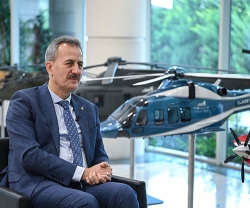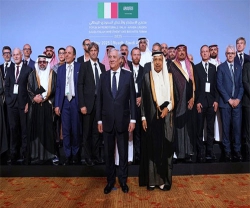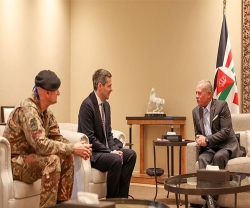World military expenditure reached $2,718 billion in 2024, an increase of 9.4% in real terms from 2023 and the steepest year-on-year rise since at least the end of the cold war. Military spending increased in all world regions, with particularly rapid growth in both Europe and the Middle East.
The top five military spenders - the United States, China, Russia, Germany and India - accounted for 60% cent of the global total, with combined spending of $1,635 billion, according to new data published by the Stockholm International Peace Research Institute (SIPRI), available at www.sipri.org
Global military expenditure witnessed the 10th year of consecutive rises in 2024. The world’s 15 largest spenders all increased their military expenditure. The global military burden - the share of global Gross Domestic Product (GDP) devoted to military expenditure - increased to 2.5% in 2024.
“Over 100 countries around the world raised their military spending in 2024. As governments increasingly prioritize military security, often at the expense of other budget areas, the economic and social trade-offs could have significant effects on societies for years to come,” said Xiao Liang, Researcher with the SIPRI Military Expenditure and Arms Production Programme.
European Spending Surge Drives up Global Total
Military spending in Europe (including Russia) rose by 17% to $693 billion and was the main contributor to the global increase in 2024. With the war in Ukraine in its third year, military expenditure kept rising across the continent, pushing European military spending beyond the level recorded at the end of the cold war. All European countries increased their military spending in 2024 except Malta.
Russia’s military expenditure reached an estimated $149 billion in 2024, a 38% increase from 2023 and double the level in 2015. This represented 7.1% of Russia’s GDP and 19% of all Russian government spending. Ukraine’s total military expenditure grew by 2.9% to reach $64.7 billion - equivalent to 43% of Russia’s spending. At 34% of GDP, Ukraine had the largest military burden of any country in 2024.
Several countries in Central and Western Europe saw unprecedented rises in their military expenditure in 2024 as they implemented new spending pledges and large-scale procurement plans. Germany’s military expenditure increased by 28% to reach $88.5 billion, making it the biggest spender in Central and Western Europe and the fourth biggest in the world. Poland’s military spending grew by 31% to $38.0 billion in 2024, representing 4.2% of Poland’s GDP.
“For the first time since reunification Germany became the biggest military spender in Western Europe, which was due to the €100 billion special defence fund announced in 2022,” said Lorenzo Scarazzato, Researcher with the SIPRI Military Expenditure and Arms Production Programme.
Spending in a Record Number of NATO Members
All NATO members increased their military expenditure in 2024. Total military spending by NATO members amounted to $1,506 billion, or 55% of global military expenditure. Of the 32 NATO members, 18 spent at least 2.0% of GDP on their militaries, according to SIPRI methodology, up from 11 in 2023 and the highest number since NATO adopted the spending guideline in 2014.
Military spending by the USA rose by 5.7% to reach $997 billion, which was 66% of total NATO spending and 37% of world military spending in 2024. A significant portion of the US budget for 2024 was dedicated to modernizing military capabilities and the US nuclear arsenal in order to maintain a strategic advantage over Russia and China. European NATO members spent $454 billion in total, representing 30% of total spending across the alliance.
Middle East Military Spending Soars
Military expenditure in the Middle East reached an estimated $243 billion in 2024, an increase of 15% from 2023 and 19% more than in 2015.
Israel’s military expenditure surged by 65% to $46.5 billion in 2024, the steepest annual increase since the Six-Day War in 1967, as it continued to wage war in Gaza and escalated conflict with Hezbollah in southern Lebanon. Its military burden rose to 8.8% of GDP, the second highest in the world. Lebanon’s military spending rose by 58% in 2024 to $635 million, after several years of lower spending due to economic crisis and political turmoil.
“Despite widespread expectations that many Middle Eastern countries would increase their military spending in 2024, major rises were limited to Israel and Lebanon,” said Zubaida Karim, Researcher with the SIPRI Military Expenditure and Arms Production Programme. “Elsewhere, countries either did not significantly increase spending in response to the war in Gaza or were prevented from doing so by economic constraints.”
Iran’s military spending fell by 10% in real terms to $7.9 billion in 2024 despite its involvement in regional conflicts and its support for regional proxies. The impact of sanctions on Iran severely limited its capacity to increase spending.
China and its Neighbours Continue Military Build-Ups
China, the world’s second largest military spender, increased its military expenditure by 7.0% to an estimated $314 billion, marking three decades of consecutive growth. China accounted for 50% of all military spending in Asia and Oceania, investing in the continued modernization of its military and expansion of its cyberwarfare capabilities and nuclear arsenal.
Japan’s military spending rose by 21% to $55.3 billion in 2024, the largest annual increase since 1952. Its military burden reached 1.4% of GDP, the highest since 1958. India’s military expenditure, the fifth largest globally, grew by 1.6% to $86.1 billion. Spending by Taiwan grew by 1.8% in 2024 to reach $16.5 billion.
Other Notable Developments
In 2024 the United Kingdom increased its military expenditure by 2.8% to reach $81.8 billion, making it the sixth biggest spender worldwide. Military expenditure by France rose by 6.1% to reach $64.7 billion, making it the ninth biggest spender.
Sweden increased its military expenditure by 34% in 2024, to $12.0 billion. In its first year of NATO membership, Sweden’s military burden reached 2.0% of GDP.
Saudi Arabia was the largest military spender in the Middle East in 2024 and the seventh largest worldwide. Its military spending saw a modest increase of 1.5%, reaching an estimated $80.3 billion, but still 20% lower than in 2015 when the country’s oil revenues peaked.




















